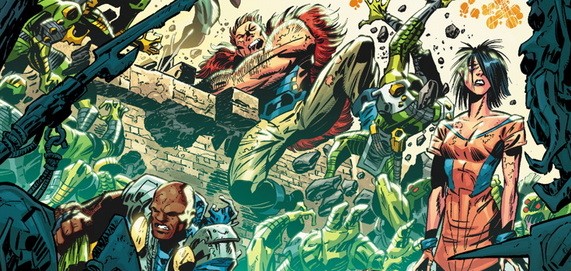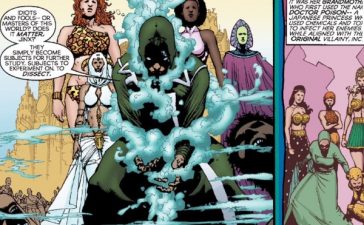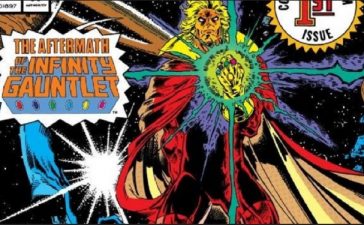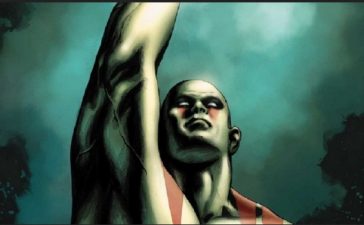
When discussing Marvel’s cosmic line, there is one creator whose name towers over all the others: Jim Starlin. However, as remarkable as Starlin’s contributions have been, his voice has never been the sole one. After all, Starlin did not create this corner of the Marvel Universe. As with so much else, credit for that probably resides in the pages of Stan Lee and Jack Kirby’s Fantastic Four, where they debuted characters such as the Skrulls, Galactus, Silver Surfer and Him. It was expanded upon by Roy Thomas through his transformation of Him into Adam Warlock. Most importantly, Thomas wrote The Kree-Skrull War, which was the largest scale, space-faring epic Marvel’s heroes had found themselves in up to that point. It was on this groundwork that Starlin built his cosmic masterpieces.
Starting in 1972 (the same year that Thomas wrapped up Kree-Skrull War), Starlin began his cosmic explorations. Over the next decade he would introduce Thanos, revamp Captain Marvel, redefine Adam Warlock, and create a score of memorable characters. He infused his stories with not only science-fiction grandeur, but philosophical questions about the nature of life itself. He would experiment with page layout. He would also write a death for Captain Marvel which remains so iconic that thirty years later, Marvel has not had the nerve to undo it. If that was not enough, he began a second wave of cosmic work at Marvel lasting from the early 90s to the early 00s, and in doing so extended his imprint on Marvel’s cosmic titles into a whole new generation of fans (myself included).
This second wave of Starlin ended in 2003 with his departure from Marvel. (Whether Starlin’s upcoming Thanos graphic novel heralds a third wave for him at the publisher remains to be seen). Soon thereafter, Marvel used the Annihilation event, along with its sequel Annihilation: Conquest to shake up the contours of their cosmic line. In the aftermath of Conquest, the cosmic titles rested in the hands of writers Dan Abnett and Andy Lanning, who would refashion them in such a way that their work is the template for not only those who followed them on the comics, but also the upcoming Guardians of the Galaxy film.
These milestones are all well-established. Today I would like to focus more on the less remarked-upon contributions of Keith Giffen to the cosmic line. He only worked on the books briefly, yet in that short time he transitioned the Starlin era into the contemporary one.
Appropriately enough, Keith Giffen’s first contribution in this project was to take over a title from Starlin. Not just any series either, but one starring Starlin’s most famous creation: Thanos. Most notable in these six issues is the twist which Giffen adds to Thanos’ relationship with Death. After years of silent rebukes, Death finally speaks, only her words form further admonishments. She asks why he has always pursued wholesale massacres in the hope that he might win her love in that way. All those souls he killed would have been hers eventually anyway, and besides what great gift is it to give Death more death? Could he not think of something more personal to offer her? It is an interesting conversation that allows for a new perspective on one of the core components of Thanos’ nature. It also serves as a reminder that Thanos is more than a brutal killing machine.
A year after concluding the Thanos series at #12, Giffen was the primary creator behind the Annihilation event. Besides writing the main book, he tackled some of the prelude and tie-in series. The most notable of these would be Drax the Destroyer. This four issue mini-series starts with a prison transport ship crashing into Earth, the survivors of which are Drax, the Blood Brothers and Paibok the Skrull. Paibok quickly asserts authority over Blood Brothers and uses their combined might to take control of a small town in Alaska. It is in this narrative that Drax is reborn with the design that readers recognize today. Also, Giffen introduces a new character, a teenage girl, Cammi. Some of her arc might be predictable (the moment she begins talking about how much she wishes there was more to life than this town, you know she will be traveling through space by the story’s end). However, Cammi is a charming character who works well as a foil with Drax, and later in Annihilation, with other powerhouses of the Marvel Universe. The whole narrative is quite enjoyable, and my favorite story to focus so strongly on Drax. Finally, it is a good reminder of how Drax is so much more than a grunting muscle-man. (Starlin’s decision in the 90s to give Drax a child’s level of intelligence is probably one of his greater misfires)
Annihilation is remembered as one of the best Marvel events of the 00s, a reputation it lives up to. In the main series, Giffen tells a thrilling story of heroes, as well as adversaries, joining together to defeat the armanda of Annihilus. This comes at great cost, and, the landscape of the universe is vastly changed in the aftermath. Save for one, the Nova Corps is decimated. Quaser is dead, along with Thanos. The Supreme Intelligence is gone, and Ronan finds himself in command of what is left of the Kree Empire. As is often the case with comics, many of these changes have been undone by later writers, yet the stories themselves retain their drama. Annihilation aims for a galaxy-spanning epic, and succeeds in that goal.
It also succeeds so well, that it leads directly into a sequel, Annihilation: Conquest. Giffen’s contribution to this event was lesser in terms of quantity, but just as important, if not more so, in terms of substance. Ever since his six-issue arc for Thanos, Giffen had been gradually reintroducing readers to a second-tier space adventure by the name of Peter Quill, Star-Lord. During the events of Thanos, Quill is a resident of a high-security space prison, brooding over his failure to prevent 350,000 deaths, along with the destruction of his beloved Ship. During the Thanos story, Quill stays mostly on the sidelines, disinterested in heroics. Events have made him cynical. In his mind, the universe can simply fall apart, as long as it leaves him be.
Yet, in his heart, Quill, is still a hero, even if he bristles at the mention of “Star-Lord.” The sheer scope of the carnage caused by the Annihilation Wave stirs Quill to action. In a previous post, I reflected on how Star-Lord’s earliest stories were reminiscent of the archetype of the lone gunman traveling an untamed frontier. This overlap between genres continues in Giffen’s portrayal of the character gradually emerging from isolation to accept his duty to others. In other words, the type of role Clint Eastwood could probably do in his sleep.
What Giffen did next, though, was nudge Peter Quill away from this persona. Giffen’s sole contribution to the Conquest event was a four-issue limited series, Star-Lord. The Kree homeworld Hala has fallen to the Phalanx, and Quill, who feels partially responsible, is charged with leading a team behind enemy lines. Members of this odd assortment of personalities include Rocket Raccoon, Groot, Mantis and Bug, characters who would all play prominent roles in Abnett & Lanning’s Guardians of the Galaxy series (itself, more or less, a spinoff from Conquest). Indeed, Quill would be motivated by the events of Conquest to form his own team of heroes so that the cosmos is not left so vulnerable in the future. It is here where not only Quill accepts the responsibility of leadership, but also begins to loosen up a little. Interaction with teammates serves as a counterbalance to his former melancholy, and readers get their first glimpse of the Star-Lord who would take center stage in DnA’s Guardians series. This is not to say that Quill loses his ability to be serious—far from it. The character which Giffen sets up, and DnA fill out so superbly, is a mixture of smart-aleck and determination. Instead of appearing a lightweight, this is a man who has saved the entire universe more than once, even if it means the sacrifice of his own life.
In such a way, Giffen builds a bridge between two eras of Marvel’s cosmic characters. As often happens with transitional creators, his contributions are overshadowed by what came before and after him. True, he did not define a period in the manner of Starlin and DnA; however, his work is still important. Even better, they are enjoyable comics, especially the Star-Lord series, which is a terrifically fun read. When the time comes, Giffen will be remembered for a variety of projects; his Marvel cosmic work of the mid-00s should be among them.








